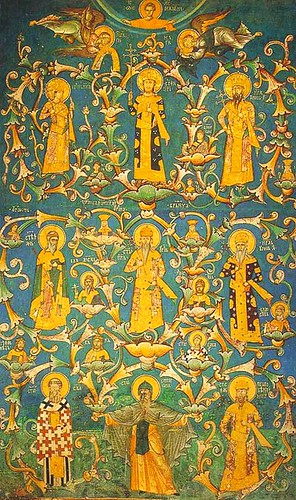
The Nemanjić Dynasty Tree
Chicken breasts are mildly salted and generously rubbed with honey. Leave it to rest for two hours to chill. Roll in wheat flour and fry in pork fat until golden. Remove meat from the pan, pour in white wine, minced garlic and a little dried thyme. Pour this sauce over the meat.
This is a recipe from 1196. To be more precise, that year it was served on the court of Stefan Prvovenčani. This is one of the oldest known dishes served on the courts of the Nemanjić dynasty. This, and a few other recipes were rediscovered by collaborators of a Belgrade Production House Vertikal Media. They managed to gather plenty of material about medieval Serbian cuisine, with the help of culinary experts, professors, historians and some freelance researchers.
I met with Danilo.Vučinić, the mastermind and the initiator of the project and in a pleasant informal interview/meeting, in one of the Belgrade’s finest seafood restaurants Bastion 2 (Beograd, Braće Ribnikar 40), he was kind to share parts of the story he is working on. It all started as a research of eating culture during the time of the Nemanjić dynasty, but the subject appeared to be much larger than Danilo.Vučinić thought and gave extentive amount of material. The 15 year old adventure of this research will be crowned next year in October with the monumental book about Serbian history through gastronomy, including not only the meals of the Nemanjić dynasty, but also Obrenović and Karađorđević dynasties.
What I wanted to know was how do they know the recipes? Where did they find them? The man we have to thank for the most of the material is Theodore Metochites, a Byzantine statesman, author, gentleman philosopher, and patron of the arts. He visited Serbia five times and well documented about wealth and glory he witnessed on king Milutin’s court.
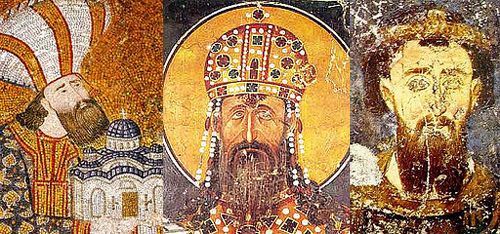
Although, the bloom of culinary art in Europe is considered to be during the time of the Renaissance, Serbia of that time can not laud that it followed it’s trail. This is mainly because the fact that it was the Ottoman empire vasal state during that time. But, during the reign of the Nemanjić dynasty, starting with kings Radoslav and Milutin, continuing during the reign of emperor Dušan “the Mighty”, to the last Uroš “The Weak”, culinary art was shoulder to European, and in some segments way ahead many European countries.
The story begins with Stefan Nemanja. Holy Roman Emperor Friedrich I Barbarossa and his 100,000 men army were hosted by the Grand Prince Stefan Nemanja in Niš, during the Third Crusade, in late July, 1189. Diplomatic agreement was signed, a “friendship” between the two countries and Stefan Nemanja signed his name in Cyrillic while Barbarossa could only manage a thumbprint. Stefan Nemanja arranged a dinner in Barbarossa’s honor. And as Theodore Metochites wrote down Barbarossa said: “Serbian people are the most hospitable people in the world and that is why they should not be harmed by any means“. It was a 21 course meal, with fish, game and seal specialties. Seals?! In Serbia in the XII century?! This was a mystery for Danilo.Vučinić for many years, until he learned of the Mediterranean Monk Seal (Monachus monachus). Pieces fit perfectly!
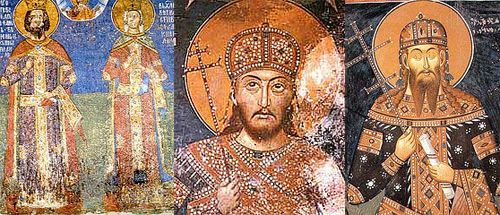
The answer to the question what was actually eaten in Serbia of that time, we must look into two directions: what did the court and nobles eat, and what the common people. On the court and in the houses of the nobles there were plenty of game meat, fish, all kinds of meats, especially ram, dried meat and bacon. Meals and eating were very important on the court. Future Tzar Lazar took care about royal dining during reigns of emperor Dušan and Uroš.
In that time fish, octopus, salted caviar were brought from Adriatic sea coast. The Nemanjić dynasty arranged that the fish is brought from Zeta to the monasteries of Studenica, Banjska, Dečani, Saint Archangels Monastery. King Vladislav gave Mileševa monastery hunting grounds in Bistrica, and Hilandar was delivered octopus, polyps and sea fish in gelatin during Great Lent. Despot Uglješa send gifts of shellfish, calamari, fish to the Monastery Saint Atanasija. From Bar they brought olive oil, and sea salt from Dubrovnik, Kotor and Bojana. After emperor Dušan’s conquering, Serbs had their salt mines in Albania and Greece. Later, salt was brought from Ugarska and Vlaška. A great warehouse of salt was in Bovan near Aleksinac, from where Tzarica Milica, wife of Tzar Lazar gave salt to the Monastery Saint Panteleimon. along with the usual herbs, such as thyme, yarrow and mint, from the coast arrived and saffron, cinnamon, anise and nutmeg.

Emperor’s Dušan Serbia
Even the ways to prepare the food were specific. For example, rumen was used for cooking – it was washed, then filled with chopped meat and vegetables and then filled with water. Then tied and placed in hot live coals or on top of the fire place. Food is prepared when 3/4 of water evaporates. All the time, no mater how much the rumen is exposed to the fire, it won’t burn.
Another way to cook was to put hot stones into milk or vegetables. In some parts of Lika and Kordun this way of cooking is still present. Roasted meat was prepared like this – slaughtered animal, along with the skin and fleece, was covered with loam (feather animals with mud) and then put into live coal ash. After the soil armor was broken, the skin would fall off with it and the meat was clean and incredibly tasty. To this day in some parts of Balkans this way of roasting is still used.
Variety of drinks was poor. Main drink was Medovača, rakija made of honey, medovina, wine made of honey was present until the end of 15th century. Domestic beer was known as “alovina” in Eastern Serbia.
Thanks to the Nemanjić dynasty wine making and grape production were highly developed. Even Stefan Prvovenčani added the law which prohibited adding water into the wine. Emperor Dušan had a big wine cellar near Prizren, and most of the monasteries cultivated grapes for wine. During Tzar Lazar’s reign, Kruševac became the center of wine industry, while Stefan Lazarević and Đurađ Branković spread vineyards around Smederevo, Vršac and Fruška Gora.
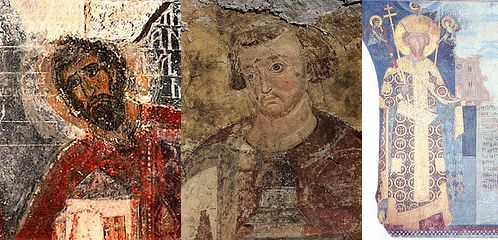
Recipes come to life
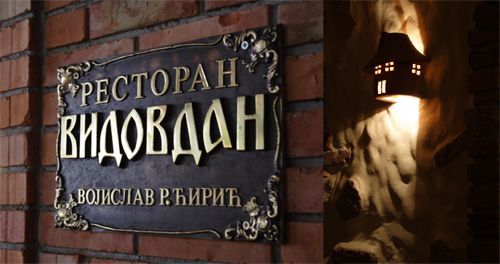
My next stop was restaurant Vidovdan. One of the Belgrade’s finest ethno restaurants, that exists since 1988. They serve Serbian national specialties, such as: ćevapčići, lamb and young beef in sač, pogača, Karađorđe’s steak. This is an ideal place to try Serbian national cuisine and accompany it with a range of artisan wines. Their adress is: Husinskih rudara 17, Karaburma, Beograd, telephone: +381112757868.

Dinig in a cosy athmospere of a Serbian log cabin,
with the most pleasant staff.

Wine in Vidovdan, I tasted wine “Savković”
For this special occasion, they were kind to make us a three course meal from the courts of the Nemanjić dynasty.
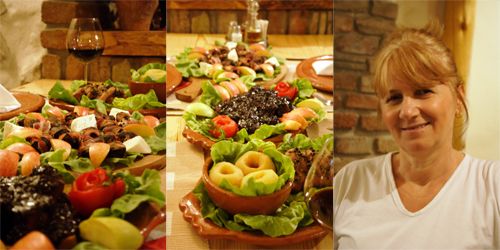
Our 3 course Medieval meal and chef Živana who revived the meals.
Beef tenderloin: Cut beef steaks into bite sized pieces and soak into rasol (liquid from sauerkraut) and leave it in there for a whole day and night. Then, take them from rasol, dry with a towel and rub with garlic and olive oil. Grill. Meanwhile, make sauce from red wine, mushrooms and blackberries. Thicken with wheat flour. This recipe is from 1290.

Pork shanks: Pork shanks are seasoned with mint, black pepper seeds and white wine. They are served with peeled apples baked in vinegar. Recipe from 1389.

Prunes: Soak prunes into water until they are soft, dry them and remove the seeds and place a piece of walnut and a piece of goat cheese in the place of seeds. Wrap with thin strips of bacon and grill. This was usually served with slices of wheat or rye bread. This recipe is from 1393.
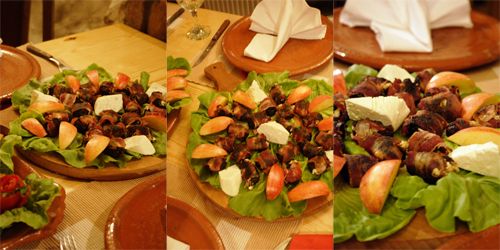
Next, I decided to make some of the meals myself. The one from the begining of the story, and two more.
Quails: Quails are stuffed with mass made of wheat, kajmak and diced porcini mushrooms. They are baked and when they’re nearly done, we pour over eggs beaten with soured milk and finish baking. They were considered delicates and were served with red wine with ice.
Obtaining quails was an adventure for itself. After days and days of futile quest for them, I convinced a guy from the local farmer market to give me the phone number of his friend who breeds them and sells their eggs. Finally, they arrived for me from Stara Pazova.
Wild boar: A dish from 1197. made with wild boar meat, garlic, honey, red wine, blackberries, white grapes.
The forks
There is this, very dear to Serbian people, anecdote about the forks. It is said that on Serbian court were eating with golden forks while whole Europe ate with their fingers, and it is associated with the reign of Milutin. The truth is, on Milutin’s court was eaten from silver dishes in special occasions, but the golden fork is actually from the time of emperor Dušan. And how comes that the fork appeared in Serbia before in many other European countries, apart from Italy? The answer lays in the Catholic church proclamation that the fork is “a sinful immorality” or “the tool of the Devil”. The use of it was allowed at the end of 15th century. Serbia was not affected as it was an orthodox country.
The verdict: This was a fantastic experience! FoodBuzz, thank you for organizing 24 Meals, 24 Hours, 24 Blogs! I loved all the dishes I tasted, but the prunes are my absolute favorite!
I realize that with this story we only scratched the surface of the bigger one. And I am eagerly anticipating for the finished version of the book. And I know that Danilo.Vučinić will discover more to this story, as he will, next summer, with the blessing of Metropolitan of Montenegro and the Coast lands Amfilohije Radović, visit certain monastery’s libraries and go through the ancient scripts.
Resources: Wikipedia’s history of Serbian medieval state, article “Carska trpeza Nemanjića” by Momir Čabarkapa.
Thank you: Danilo.Vučinić, FoodBuzz, Mateja for helping me eat all the food in Vidovdan :), Vojislav Ćirić and restaurant Vidovdan, News Company “Novosti”, Vertical Media Production House, Vlada and Miroslav from Stara Pazova.

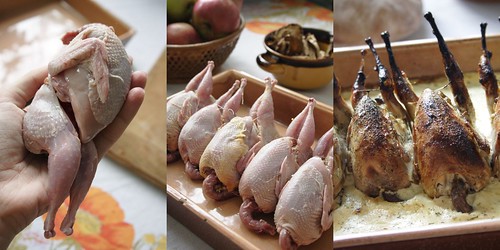

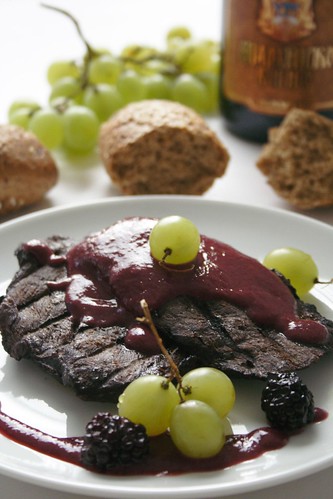

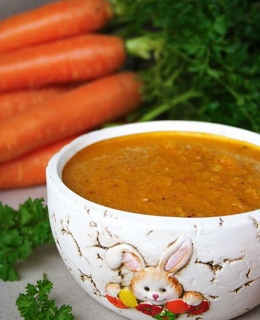
59 Comments
Wow!!!! Palachinka… that is a History Lesson :D. Amazing post with such valuable information!!! You did a wonderful research here :D Good job!!!I love to know the recipes’ date of birth ;D
A great post very informative and interesting! We know so little about Serbia… Delicious looking food too!Cheers,Rosa
Quite amazing !! Very informative and interesting, the photos are stunning as well
odličan post krcat zanimljivom povijesnim činjenicama i informacijama…uvijek je zanimljivo vidjeti što i kako se nekada jelo…pozdrav od monchi
Marija,What a tremendous post! I’ve been eagerly waiting for it since I saw what you were going to write about.Wow!!! Blending history and food so effortlessly. I was fascinated by those old, old recipes. That chicken recipe with honey sounds amazing. I think I’d pass on the seal though. ;)Thank you so much for gathering all this information into such a wonderful post.
Amazing, detailed, informative write up! I learnt quite a bit about Serbian history and cuisine after reading your post. Love all the photos and your culinary re-creations too
Fantastic concept! I especially love the wild boar dish.
Fantastic concept! I especially love the wild boar dish.
Fantastic concept! I especially love the wild boar dish.
Fantastic concept! I especially love the wild boar dish.
Fantastic concept! I especially love the wild boar dish.
This was so interesting! And some of it still sounds tasty (although I am really not sure about cooking in sauerkraut liquid).
Wow! What a fantastic post! The restaurant meal looks amazing but I really love the look of your quails and the wild boar with the fruits – stunning. Congratulations on your post!
I have studies Byzantine Archaeology and I must admit that tjis meal is very interesting! Great post…and very yummy pictures too!
Marija, congrats on being chosen to be part of “24” an thank you for showcasing such a rich and delicous array of Serbian food.
Incredible! And so informative. I love food history, but it’s so hard to find good information. Great post!
What rich history and a beautiful display of your country in food. That quail looks amazing! Congratulations on your beautiful post.. I can’t wait to come back and visit again!
WOW! That was so interesting! I loved reading all the history of the food. Every dish sounds so unique and delicious! What a fantastic experience!
Food and history are two of my favorite topics so this was fascinating reading. What a unique and innovative dinner idea. Beautiful pics too. I know you said you had a hard time finding the quails. Was it hard to find wild boar?
@miami dish: Actually, no. We have wild boar in every supermarket, but quails no
The prunes are one of my all time favorite dishes, I just can’t get enough of them. I’m gonna have to visit Vidovdan next time I’m in Belgrade (I live in NS)
Wow this is awesome! Thanks for the history/cultural lesson. It makes me want to visit Serbia to try some of these dishes out!
That was such an interesting post; i really had no idea about any of this history.
Fabulous Marija…Iloved the journey & to think that you've just scratched the surface! Congrats for making the 24!! Well done!
Very interesting history indeed! The quail dish looks fantastic. Would definitely like to try that.
That was amazing… and so interesting Thank you!
Thank you!
Really fabulous and fascinating, and I love the way you did the round-up at the end. Congrats on tackling this huge endeavor!
Wow! What a wonderful post. Congrats on your 24 success. I really enjoyed the history and going back in time through your post
I love learning about food history, especially for cuisines I’m not familiar with. Great research!
What an amazing post, Marija! So informative, beautifully written and illustrated! Thanks to you I now know more about Serbian history and cuisine!
Wow! Marija! Thank you so much for this post! I have learned so much culture, history and food – all in one! If only we could go back to eating like the people back in history, I think we would all be healthier – wild boar (instead of farm-raised pigs) quails, etc.
This is an absolutely wonderful post in every way. Great photos, great history, great food. Thank you so much for posting it! I hope the book your friend is working on will someday be published in English – I’d love to read it.
This is amazing! It is wonderful to learn about other cuisines and the history behind them. Thank you for this very informative piece.
Marija, what a wonderful, interesting post! I truly enjoyed reading it. And the photos are simply amazing!
I am so jealous! Visiting those restaurants must have been real work!
Just incredible! I love the pictures and the history. And the food! Such a great, thorough study you have done. I had no idea that forks were instuments of the devil. I have a whole drawer of them. I might be in trouble. You have done a wonderful job with this report and you should be very proud of your work.
What a gorgeous post. I take my hat off to you. Your whole blog is inspiring.
I really enjoyed the blending of the historical and the culinary in your post. Wow!
Wow, what an incredible history lesson. I love the little tid bit on the ruler known as “the weak”. I certainly hope he got that title AFTER his reign…If not, talk about a buzz kill!thank you for all the great information and the wonderful way you’ve linked us all together!Brooke
WOW!!! Everything looks so good, and such an interesting and informative post too.You have an award waiting on my blog
I LOVED that post. It might be because I’m an art history PhD student, but I’m a total nerd for history. Combine that with my other love, food, and you’ve got an avid fan. If you have the time and initiative, I’d love to read more posts like that one!
This is a great post. I know next to nothing about Serbian food, so found every bit of it very fascinating. Thank you!
Thank you everybody! I am so happy you enjoyed reading the post!
I had to bookmark this post until I had the time to read it properly. What a great post! Those recipes stand the test of time!
Glorious post!
What a great job!!! Congratulations! Didn’t expect anything less from you! Wonderful post, informative, amazing, great pictures! I wish I could have come to Serbia this year, but next year for sure! Now I know where we will dine! It will be great to rediscover my own roots! Fabulous, Marija!!!
Fantastic! Beautiful history.Thank you for sharing,Claudia
Hej! Slucajno sam nasla tvoj blog, pa mi je bas bilo drago kada sam skuzila da si iz exYu (Beograd?). Ides u moje favorite! Odlicne fotke!
Wow… I SO want to get my hands on some of the recipes. I specialise in cooking medieval and renaissance food, and while I have cooked Catalan, Italian, French, English medieval dishes, I have NEVER cooked Serbian!
Wonderful web site. Plenty of useful information here. I am sending it to some friends ans also sharing in delicious. And naturally, thanks for your effort!
Honey garlic chicken breast is my favorite dish as well as wings are. I wouldn’t be surprised if hot wings originated from Tunisia or some other Mediterranean country that cooks spicy food.
Where can I find the prune recipe?
You have it here in the post
Very cool. I'm fascinated with ancient cuisines and methods. Thanks!
Hi,I just found this post, and I'm wondering if the cookbook is published yet? What is it called, author, where can I buy a copy?Loved this very much!
Paula, it still isn't published. I am waiting for this book to come out. I don't know what happened with the author If and when it comes out, I'll organise a giveaway here on blog.
If and when it comes out, I'll organise a giveaway here on blog.
Amaizing receipe,congratulations,keeping receipe all the best,
Any word on the book? I haven’t searched your blog to see if you did the giveaway, or if the book is out and if I can find it anywhere?
Thanks!
Paula, I saw the guy about a year ago and he was still working on the book. Publishing business in Serbia is so tough
Comments are closed.